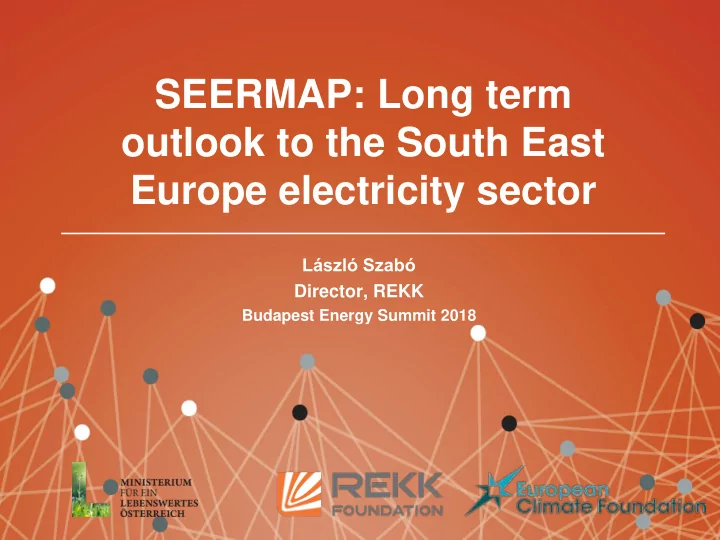

SEERMAP: Long term outlook to the South East Europe electricity sector László Szabó Director, REKK Budapest Energy Summit 2018
Outline Main issues to consider: • Why the SEE region is important for us? • Strong connection to CEE, price dynamics is influenced by SEE • Investment opportunities • Long term energy transition - What is the role of RES, natural gas and coal in the SEE markets? • Impacts and cooperation opportunities with CEE (e.g. in RES investments, reserve sharing etc.) • Does the system provides enough flexibility in 2030? 2
The SEERMAP and Agora projects Project title South East European Electricity Roadmap (2017) Albania, Bosnia, Kosovo, Montenegro, Macedonia, Region Serbia, Romania, Bulgaria, Greece Partners REKK (lead), TU Wien, OG Research, EKC Donors Austrian Federal Ministry of Agriculture, Forestry, Environment and Water European Climate Foundation www.seermap.rekk.hu Web ➢ Analyse the impact of the transition to a low carbon and Objectives energy secure pathway the electricity sector until 2050 ➢ Develop of a Long Term Electricity Roadmap for SEE AGORA project on system flexibility (2018) Assessment on ➢ AGORA project: analyse the system over a full year if flexibility sufficient flexibility is present 3
Models applied and interlinkages EPMM* EPMM*: Unit Commitment model to analyse system flexibility in a full year 4
Three scenarios No Target Delayed Decarbonization Delayed Ambitious CO 2 target No target implementation decarbonisation policy Many new coal Many new coal Fossil plants Only few coal plants plants plants Continuation of Ambitious RES SEERMAP RES target NO new RES Support current policies support 5
MODELLING RESULTS FOR THE SEERMAP REGION 6
Installed capacity • Gradual phase out of fossil capacities • Role of natural gas is uncertain: bridging role in ‚decarbonisation’ and ‚delayed’ scenario, where gas is crowded out from the market, and more permanent role in the ‚no target’ • Dynamic uptake of RES technologies, especially wind and solar 7
Fossil and RES investment cost • All scenarios require dynamic investment uptake in the region. • RES investment costs dominate the post 2020 period • EnC countries will have to follow competitive procurement of RES investments • Source of financing: EU and IFIs 8
WHAT IS THE ROLE OF NATURAL GAS IN SEE OVER THE LONG TERM? 9
Natural gas consumption in electricity generation • Bridging role of natural gas in all scenarios • In ‚delayed’ and ’ decarbonisation ’ scenario gas based generation is crowded out from the market by 2050 • GR, RO and BG are the large gas consumers. In WB6 AL, MK and RS show the highest increase 10
Gas infrastructure plans in CEE and SEE • Eastring, BRUA, South Stream would deliver the same volumes to the same markets • Competing infrastructures, risk of non-realisation • Do we need all these infrastructure developments for the long term supply? 11
DOES THE ELECTRICITY SYSTEM OF SEE HAS ENOUGH FLEXIBILITY? 12
EPMM: Critical week assessment: electricity mix – winter, SEE region 2017 2030 45 000 45 000 40 000 40 000 35 000 35 000 30 000 30 000 25 000 25 000 Capacity,MW Capacity,MW 20 000 20 000 15 000 15 000 10 000 10 000 5 000 5 000 0 0 1 13 25 37 49 61 73 85 97 109 121 133 145 157 1 13 25 37 49 61 73 85 97 109 121 133 145 157 -5 000 -5 000 Nuclear Other RES Coal and lignite Natural gas Nuclear Other RES Coal and lignite Natural gas Wind HFO/LFO Hydro PV Wind HFO/LFO Hydro PV Missing production Pumped storage Consumption Net import Missing production Pumped storage Consumption Net import ➢ More variability in production, export and pump storage by 2030 due to higher RES but the SEE system balances! 13
EPMM: Critical week remaining margin – winter, SEE Region 2017 2030 70 000 200% 70 000 200% 180% 180% 60 000 60 000 160% 160% 50 000 50 000 140% 140% Capacity margin, % Capacity margin, % 120% 120% Capacity, MW Capacity, MW 40 000 40 000 100% 100% 30 000 30 000 80% 80% 60% 60% 20 000 20 000 40% 40% 10 000 10 000 20% 20% 0 0% 0 0% 1 13 25 37 49 61 73 85 97 109 121 133 145 157 1 13 25 37 49 61 73 85 97 109 121 133 145 157 Total production Total upward reserve Available import Total production Total upward reserve Available import Missing production Consumption Reserve margin Missing production Consumption Reserve margin ➢ Reserve margin does not fall below 35% in 2030 on regional level, except if new interconnectors are not built (NTCs) * Available import: Additional import possibilities taken into account above the utilised ones 14
Conclusions • RES deployment increases in all scenarios, even without support significant growth after 2040 RES • To secure financing is a key - role of IFIs and EU! • Opportunity to CEE investors as well • Role of gas is transitionary in electricity generation: Natural • in the ‚no target’ scenario it peaks at 2040 • in the ‚delayed’ and ‚decarbonisation’ scenarios it is fully replaced gas by RES by 2050 • Gradual elimination of coal capacity and production in all scenarios Coal • Very low utilization from 2040 onwards (below 20% - closure) • Stranded cost in these assets ranges between 2-8 €/MWh 15
Thank you very much for your attention! laszlo.szabo@rekk.hu www.rekk.hu www.seermap.rekk.hu
Recommend
More recommend